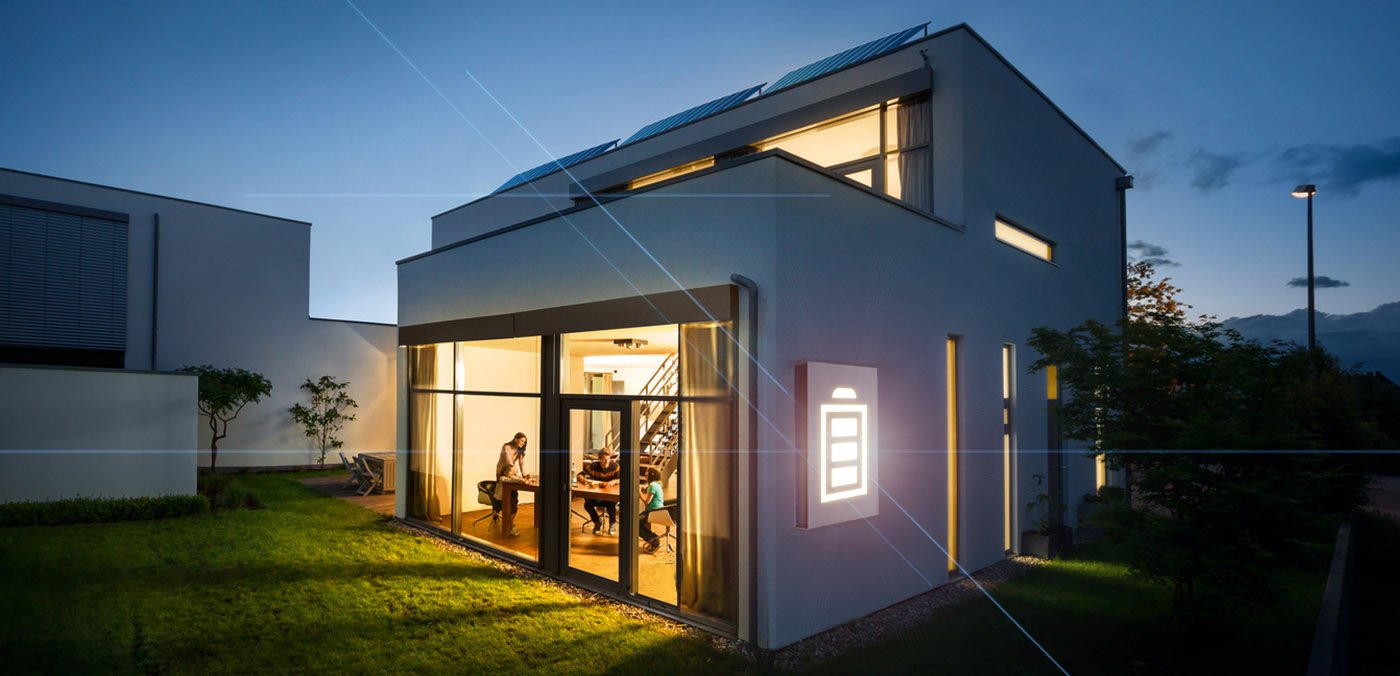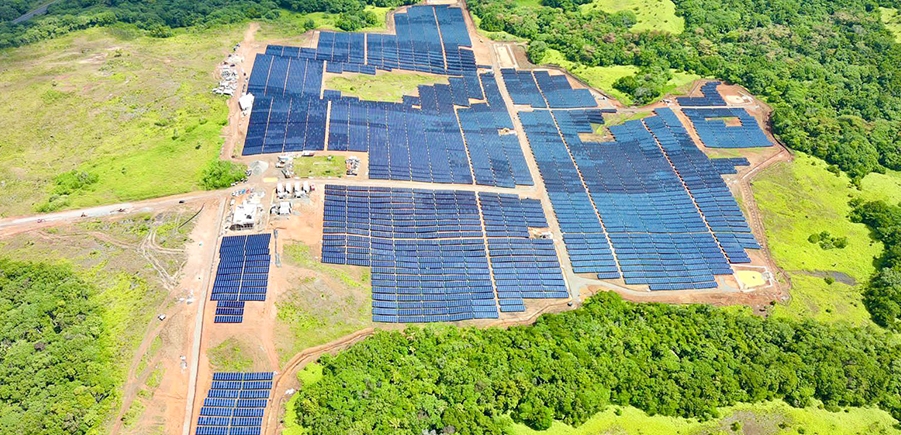Battery-Storage Systems: The Path to 100% Solar Power for Your Home

More than 70 percent of all PV systems connected to the grid now have a battery-storage system. Why? Because more and more cost-effective batteries ensure that solar power is also available after sundown. Anywhere in the world. Even in your home?
Did you know that electricity costs account for around 30 percent of the ongoing operating costs of a typical single-family home? After heating costs, this is probably the second biggest item in your budget. If this electricity comes from conventional power plants, it places a strain not only on your household budget, but also on the climate. And that may not warm up by any more than 1.5°C to at least prevent the most serious consequences of climate change.
There is nothing difficult about supplying electricity from renewable sources rather than fossil fuels.
The sun, for example, provides us with ten thousand times as much energy than the Earth’s entire population requires in a year, all free of charge. The best part is that with the right technology, anybody can integrate the sun as a regenerative energy source into their household. Falling prices for PV and battery-storage systems make these kinds of options an attractive alternative to electricity generated from coal or by nuclear power. Electricity from the solar system is not only far less damaging to the climate, but operators of such a system can also save up to 80 percent on their electricity costs. It couldn’t be easier.
You benefits:
- Sustainable and free solar power supplied around the clock
- Independence from electric utility companies and conventional energy sources
- Making a more active contribution to the energy transition and being a role model for others
- Minimized electricity bill
- Reliable electricity supply even in the event of grid failure
- Selling your own electricity in the future as well
The energy transition for your home
- Do you want to produce your own solar power and use it in your home?
 With a storage system, you can become independent from conventional electric utility companies and rising electricity costs. In terms of device communication, it is best to comply with uniform communication standards such as EEBUS. This makes it easier to connect the devices and exchange data, thus saving on additional interfaces. We recommend that you take a moment to think about the future here: can the system be expanded if you also want to integrate e-mobility at a later date, for example?Tip: If your roof allows it, you can achieve an optimum self-consumption rate with an east-west alignment of PV modules or by having them face southeast or southwest. In this way, you are following the sun’s natural path, in contrast to a purely south-facing alignment. The battery then gathers surplus electricity and can be designed with smaller dimensions accordingly.
With a storage system, you can become independent from conventional electric utility companies and rising electricity costs. In terms of device communication, it is best to comply with uniform communication standards such as EEBUS. This makes it easier to connect the devices and exchange data, thus saving on additional interfaces. We recommend that you take a moment to think about the future here: can the system be expanded if you also want to integrate e-mobility at a later date, for example?Tip: If your roof allows it, you can achieve an optimum self-consumption rate with an east-west alignment of PV modules or by having them face southeast or southwest. In this way, you are following the sun’s natural path, in contrast to a purely south-facing alignment. The battery then gathers surplus electricity and can be designed with smaller dimensions accordingly.
What you need for a solar storage system:- Suitable (roof) space
- PV modules
- PV inverter
- Battery inverter
- Battery
- Energy manager or energy meter
- Switch box for electricity supply even in the event of a grid failure (optional)
- Do you already have a PV system and want to add a storage system?
 If you expand your PV system by adding a storage system, you can use even more valuable solar energy yourself instead of feeding it into the utility grid. This increases self-consumption and is an attractive alternative to feed-in tariffs that are expiring. Your PV system is probably configured so that the PV modules are south-facing (facing north in the Southern hemisphere) for maximum energy yield. The battery-storage system then ensures that energy is temporarily stored when there is a high energy yield for use when the yield is lower. This enables you to significantly increase self-consumption of your solar power.
If you expand your PV system by adding a storage system, you can use even more valuable solar energy yourself instead of feeding it into the utility grid. This increases self-consumption and is an attractive alternative to feed-in tariffs that are expiring. Your PV system is probably configured so that the PV modules are south-facing (facing north in the Southern hemisphere) for maximum energy yield. The battery-storage system then ensures that energy is temporarily stored when there is a high energy yield for use when the yield is lower. This enables you to significantly increase self-consumption of your solar power.
At the same time, you are making an important contribution to climate protection because you are reducing CO2 emissions with every kilowatt hour of non-fossil energy. Tip: You can easily look up how much CO2 you have already saved with your system via the Sunny Places online portal.
What you need for your storage system:- Battery inverter
- Battery
- Energy manager or energy meter, if not already present
- Switch box for electricity supply even in the event of a grid failure (optional)
- Do you want to expand your existing storage system? Are you planning family growth? Or perhaps in the future you want to refuel an electric car, use a heat pump for heating or enjoy a reliable supply of electricity even in the event of a grid failure? AC-coupled systems are the easiest to expand. Unlike in DC-coupled systems, all generators and loads in an AC grid can be connected in parallel in AC-coupled PV storage systems. Therefore, modular expansion of AC-coupled systems is also possible at any time. These systems always evolve along with your own personal requirements.
Tip: Ask your installer for AC-coupled solutions right away. This way, you remain as flexible as possible. Because: who knows today what will be important tomorrow?
How to calculate the payback period of your solar storage system:

Of course, it is not just green thinking that counts. It goes without saying that an investment should also pay off financially.
How soon this happens depends on individual factors such as system size, system location, user behavior, existing incentive programs and tax regulations.
To get at least a rough estimate of the payback period (the time that your storage system needs to enable you to break even), just compare the total expenditure with the total income.
Your expenditure:
- Investment costs over a system service life of 20 years (PV modules, inverters, accessories, acceptance and meter costs, installation costs)
- Ongoing costs (insurance, operating costs such as costs for the system’s power consumption, maintenance and repair costs)
- Interest payments, if the system is financed using a loan
Your income:
- Electricity costs that you save by consuming self-generated electricity.
- The feed-in tariff paid by the grid operator (regulated by the Renewable Energy Sources Act (EEG) in Germany)
- Subsidies such as non-recoverable grants
- Potential profit from the sale of solar power to the electric utility company
Dividing the achievable annual income by the annual expenses will result in the period after which your investment will also begin to pay off financially. From a climate perspective, it will have proven worthwhile much earlier 🙂
Tip: Not everyone has their own roof space for a solar battery-storage system. If you rent your home, you could ask your landlord whether she or he would like to use the roof space for a PV system. If this does not interest your landlord, perhaps they could lease the roof space to you and you could then operate a PV system together with other residents. Or you could also operate systems as neighborhood PV systems on suitable roof spaces that belong to sports facilities or other public facilities.
And this is what comes next
Your system will be professionally planned — from quotation to implementation — by a certified solar professional partner in your area. Find the storage experts in your country.
Learn more about storage systems in the storage system brochure Greater Independence in Your Home.
Learn more about SMA storage solutions for home systems

 With a storage system, you can become independent from conventional electric utility companies and rising electricity costs. In terms of device communication, it is best to comply with uniform communication standards such as
With a storage system, you can become independent from conventional electric utility companies and rising electricity costs. In terms of device communication, it is best to comply with uniform communication standards such as  If you expand your PV system by adding a storage system, you can use even more valuable solar energy yourself instead of feeding it into the utility grid. This increases self-consumption and is an attractive alternative to feed-in tariffs that are expiring. Your PV system is probably configured so that the PV modules are south-facing (facing north in the Southern hemisphere) for maximum energy yield. The battery-storage system then ensures that energy is temporarily stored when there is a high energy yield for use when the yield is lower. This enables you to significantly increase self-consumption of your solar power.
If you expand your PV system by adding a storage system, you can use even more valuable solar energy yourself instead of feeding it into the utility grid. This increases self-consumption and is an attractive alternative to feed-in tariffs that are expiring. Your PV system is probably configured so that the PV modules are south-facing (facing north in the Southern hemisphere) for maximum energy yield. The battery-storage system then ensures that energy is temporarily stored when there is a high energy yield for use when the yield is lower. This enables you to significantly increase self-consumption of your solar power.



Can i add a solar battery ? that is not from SMA to my Sunny Boy 5000TL HC to enable me have electricity at night? If yes? An illustrative for DIY would be appreciated because i am in Ghana and we don’t have any SMA representatives here… Thanks
Hello Uwa,
Please contact our technical SMA Service for further support in your case.
We need some more technical information in order to support you the best way possible.
Sunny regards
Christiane
Please do you have representative(s) in Nigeria? If yes, the address.
Hello Ijeoma,
Please get in contact with our Sales office for further support.
Sunny regards
Christiane
Simultaneously, you are making a significant commitment to atmosphere insurance since you are diminishing CO2 emanations with each kilowatt hour of non-fossil vitality.
Hi i would like to ask roughy.. how much would two sola pernals n the syatem n installation cost?
Hi Oscar,
As an industrial company we supply wholesale retailers with our products (mainly PV inverters, intelligent energy management systems and battery-storage solutions), who pass on our system technology to installers. Installers, in turn, assemble your customized PV systems from individual components and are responsible for commissioning. For prices you need to ask an installer.
Kind regards,
Anke